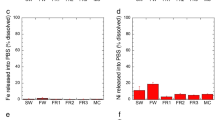Abstract
Objective: This study was undertaken to investigate the exposure to chromium (Cr) and nickel (Ni) in flux-cored wire (FCW) welders welding on stainless steel (SS). Method/design: Seven FCW welders were monitored for 3 days to 1 workweek, measuring Cr and Ni in air, blood, and urine. The welders were questioned about exposure to Cr and Ni during their whole working careers, with emphasis on the week of monitoring, about the use of personal protective equipment and their smoking habits. Results: The air concentrations were mean 200 μg/m3 (range 2.4–2,744) for total Cr, 11.3 μg/m3 (<0.2–151.3) for CrVI, and 50.4 μg/m3 (<2.0–416.7) for Ni during the workdays for the five welders who were monitored with air measurements. The levels of Cr and Ni in biological fluids varied between different workplaces. For Cr in whole blood, plasma, and erythrocytes, the mean levels after work were 1.25 (<0.4–8.3) and 1.68 (<0.2–8.0) and 0.9 (<0.4–7.2) μg/l, respectively. For Ni most of the measurements in whole blood and plasma were below the detection limits, the mean levels after work being 0.84 (<0.8–3.3) and 0.57 μg/l (<0.4–1.7), respectively. Mean levels for Cr and Ni in the urine after work were 3.96 (0.34–40.7) and 2.50 (0.56–5.0) μg/g creatinine, respectively. Conclusion: Correlations between the CrVI levels measured in air and the levels of total Cr in the measured biological fluids were found. The results seem to support the view that monitoring of Cr in the urine may be versatile for indirect monitoring of the CrVI air level in FCW welders. The results seem to suggest that external and internal exposure to Cr and Ni in FCW welders welding SS is low in general.
Similar content being viewed by others
References
Angerer J, Schaller KH (eds) (1985) Analyses of hazardous substances in biological materials. Vol 1 (1985), Vol 2 (1988), Vol 3 (1991) Viley-VCH Verlag, Wanheim
Antonini JM (2003) Health effects of welding. Crit Rev Toxicol 33:61–103
Araki S, Aono H (1989) Effects of water restriction and water loading on daily urinary excretion of heavy metals and organic substances in metal workers. Br J Ind Med 46:389–392
Emmerling G, Zschiesche W, Schaller KH, Weltle D, Valentin H (1990) Untersuchungen zur Problematik der Exposition von Lichtbogenschmelzschweissern gegenüber Chrom-Nickel-haltigen Rauch und Stäuben. DVS-Berichte, Vol. 121. DVS-Verlag GmbH, Düsseldorf
Karlsen JT, Torgrimsen T, Langård S (1994) Exposure to solid aerosols during regular MMA welding and grinding operations on stainless steel. Am Ind Hyg Assoc J 55:1149–1153
Karlsen JT, Torgrimsen T, Langård S et al (1996) Exposure to solid aerosols during ordinary MIG/MAG and TIG welding operations on stainless steel. Occup Hyg 3:377–387
Langård S, Gundersen N, Tsalev DL, Gylseth B (1978) Whole blood chromium level and chromium excretion in the rat after zinc chromate inhalation. Acta Pharmacol Toxicol 42:142–149
Schaller KH, Zober A (1982) Renale Ausscheidungen toxikologisch relevanter Metalle bei beruflich unbelasteten Personen. Das Ärztliche Laboratorium 28:209–214
Stridsklev IC, Schaller KH, Raithel HJ, et al. (1993) Biologic monitoring of chromium and nickel among stainless steel welders using the manual metal arc method. Int Arch Occup Environ Health 65:209–219
Stridsklev IC, Schaller KH, Raithel HJ, et al. (1994) Biologic monitoring of chromium and nickel among stainless steel welders using the tungsten inert gas method. J Occup Med Toxicol 3:43–55
Torgrimsen T (1982) Analysis of chromium. In: Langård S (ed) Biological and environmental aspects of chromium. Elsevier, Amsterdam, pp 149–160
Zober A, Schaller KH, Weltle D (1985) Untersuchungen zur Kinetik von Chrom und Nickel im biologischen Material während einwöchigen Lichtbogenschweissens mit Chrom-Nickel-haltigen Zusatzwerkstoffen. Forschungsbericht für die Arbeitsgemenschaft der Eisen- und Metall-Berufsgenossenschaften. DVS-Berichte, Vol. 95, DVS-Verlag GmbH, Düsseldorf, Germany
Acknowledgements
This work is part of the German-Norwegian project “Health Risks of Welding” supported by the German Bundesministerium für Forschung und Technologie grant no. 01HK288A/O and the Royal Norwegian Council for Scientific and Industrial Research grant no. AS 16944. The work was performed at the department of Occupational and Environmental Medicine, The Hospital Telemark SH, Norway.
Author information
Authors and Affiliations
Corresponding author
Rights and permissions
About this article
Cite this article
Stridsklev, I.C., Schaller, KH. & Langård, S. Monitoring of chromium and nickel in biological fluids of stainless steel welders using the flux-cored-wire (FCW) welding method. Int Arch Occup Environ Health 77, 587–591 (2004). https://doi.org/10.1007/s00420-004-0560-z
Received:
Accepted:
Published:
Issue Date:
DOI: https://doi.org/10.1007/s00420-004-0560-z




